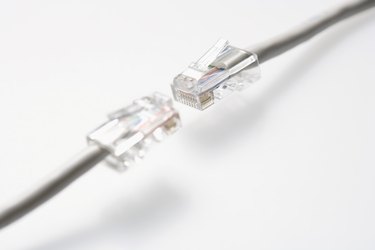
The RJ11 is the standard telephone jack in the United States. The differences between an RJ11 plug and an RJ14 plug are almost invisible to the human eye. Both connectors look exactly the same, except that the RJ14 has two more thin copper strips, housed in grooves underneath the plug, than the RJ11.
Registered Jacks
Video of the Day
RJ11 and RJ14 are both "Registered Jacks." That is what the "RJ" in their names stands for. In 1976, the US Federal Communications Commission ordered Bell Systems to define a series of telephone connectors for common usage. These new telephone jacks were published as Registered Jacks with each permutation given a separate identifying number. Bell published these standards as Universal Service Order Codes, or USOCs. These codes are in common usage to this day and define all possible jack configurations for use with the telephone system. The RJ designation actually applies to the wiring plan of both the plug and the socket, not the physical shape of the connector. A number of the Registered Jacks share the same plug, sometimes with very slight variations. The RJ11 and RJ14 jacks are an example of this.
Video of the Day
Pins and Contacts
The RJ numbers are a shorthand for a wiring plan. The USOC connectors use another scheme of abbreviation describing the facilities of the connectors. An RJ11 plug is the same size, shape and format as an RJ14 plug, they both have six pins. However, the RJ11 has only two contacts. The contacts are thin copper strips in grooves underneath the plug that make contact with the pins inside the plug, and corresponding contacts inside the socket. In USOC shorthand, the RJ11 plug, with six pins and two contacts is called a 6P2C. The RJ14 plug has six pins and four contacts, so it is a 6P4C. An RJ11 can be wired to a 6P4C, leaving the outer contacts unconnected.
Purpose
Household telephone cable contains two wires twisted around each other. The two wires are the negative and positive paths of a complete circuit. In telephone engineering circles, the positive wire is always called "tip" and the negative wire is called "ring." Of the six pins inside an RJ11 plug, only the central two pins connect to wires. The negative wire goes to pin 3 and the positive wire goes to pin 4. An RJ14 carries two telephone lines. The first line is wired the same as in the RJ11, the second line has its negative wire connected to pin 2 and the positive wire to pin 5.
Additional Use
Whereas an RJ11 connects one line to a phone and an RJ14 connects two lines, the RJ25 connects three lines. The RJ25 plug is a 6P6C and so all six pins in the plug connect to wires and contacts. The wiring for the RJ25 is the same as for the RJ14. The third line has its negative wire connected to pin 1 and its positive wire to pin 6 of the plug.